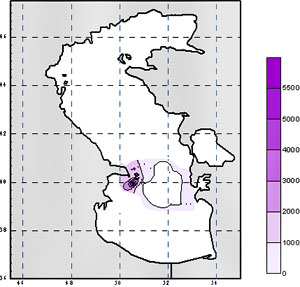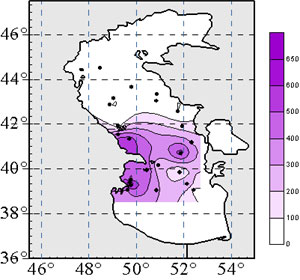Appendix 7 workshop 1
Shiganova T.A.
P.P.Shirshov Institute of Oceanology RAS,
117997 Moscow, 36 Nakhimovsky pr.
Sokolsky A.F. Kaptyuk M.I. Kamakin A. M. Tinenkova D. Kuraseva E.K.
Caspian Recearch Institute for Fisheries
414056 Astrahan, 1 Savushkina
Study of invader ctenophore Mnemiosis leidyi population and its effect on the Caspian ecosystem was organized by CaspNIIRKH with participance of P.P.Shirshov Institute of Oceanology RAS. Surveys were performed in the Northern, Middle and Southern Caspian in June, July, August and October 2001.
In June Mnemiopsis leidyi was found only in the Southern and southern part of Middle Caspian, its average density was 680± 16.8 ind..m-2*, biomass 88.3± 7.78 g.m-2, the highest density and biomass was estimated in the Southern Caspian with values 2005± 1248 ind.m-2 and 230± 197.66 g.m-2 correspondently. Reproduction was recorded in the western part of the Middle Caspian, where small sized larvae comprised 38.9% and everywhere in the Southern Caspian, where small sized larvae comprised 75.7% and temperature reached in some areas 24 i N.
In second part of July M.leidyi spread around the whole Middle Caspian, some specimens distributed to the southern part of the Northern Caspian. Average density increased in two times, reaching 1266± 1035 ind.m-2, biomass rose more than 4 times, reaching 372.7± 326.55 g.m-2, due to intensive growth of a new generation. Reproduction was recorded everywhere in the Middle and the Southern Caspian.
In August M.leidyi was distributed widely in the Northern Caspian, but in the areas where salinity was not less than 4 ‰, average density and biomass for all Caspian were maximal–9103± 5690 ind.m-2 e 954± 794 g.m-2 correspondently. The density reached 15587.5± 4182.5 ind.m-2 in the Southern Caspian, and 88% of all numbers comprised of ovae and small larvae of M.leidyi. In the Middle Caspian the highest density and biomass were recorded in the western part, there were maximal biomasses there in some stations they were higher than 3000 g.m-2. There were higher numbers of adult large specimens and lower numbers of ovae and larvae in the North Caspian, although the share of ovae and larvae were considerable.
The density of Mnemiopsis was also considerable 5375± 2145 ind.m-2 in October, but biomass decreased up to 555.9± 315 g.m-2, which probably due to increasing density of small sized specimens of new generation and elimination of large specimens after reproduction.
Thus results of investigations of Mnemiopsis leidyi population in 2001 showed that the main area of Mnemiopsis distribution was formed in the Southern Caspian, where it spends winter and than spread first to the Middle Caspian in late May or June, than in late July-August it penetretes to the Northern Caspian in areas where salinity not lower than 4 ppm. Reproduction starts in the Southern Caspian, in June, when temperature reaches 21i N. In July Mnemiopsis is reprodusing everywhere also in the Middle Caspian and in August with penetration in the Northern Caspian it reproduses there as well. Peak of density and biomass Mnemiopsis reaches in August and it lasts until late September, similar as in the Black Sea.
In 2001 Mnemiopsis reached the level of biomass, which was recorded in the Black Sea in 1988 , the density was much higher(9103 yec.i-2 for whole Caspian and 15587 yec.i-2 for the Southern Caspian) than maximal density observed in the Black Sea (7600 ind.m-2 in 1989. The size of Caspian Mnemiopsis is less than Black Sea Mnemiopsis, mean size 3-4 sm, maximal 6.4 sm.
Effect on the ecosystem was very considerable in 2001. Density and biomass of zooplankton were decreasing from month to month with increasing Mnemiosis population size. Average daily catch of kilka dropped in tree times in 2001 comparing with 2000. Since the decreasing of kilka stocks, rations and share of kilka in diet composition of beluga reduced. The high trophic web of Caspian Sea is seal, resulted in decreased kilka stocks, its main food, the share of reproductive females greatly reduced . Total dryness comprised of 79,8 % in 2001 a. , percent of pregnant females was only 10, 1%.
It is necessary urgent to develop and implement measurements to control Mnemiopsis population, in another case the Caspian ecosystem damage and decline of its fish stocks will not be able to recover.

Fig.1 Distribution of Mnemiopsis (ind.m-2) in June 2001

Fig..2 Distribution of Mnemiopsis.(ind.m-2) in July 2001

Fig..3 Distribution of Mnemiopsis.(ind.m-2) in August 2001
Document Actions
